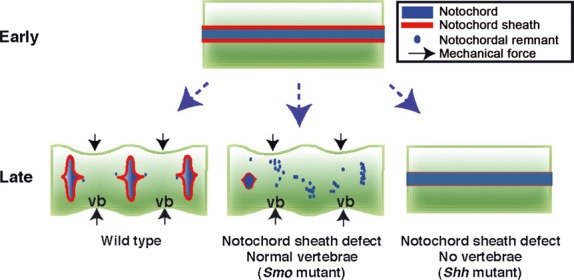Fig. 4.

An illustration of the proposed role of the notochord sheath in the formation of the nuclei pulposi of intervertebral discs. The notochord sheath (indicated by the red line) starts to form, at E10.0 (early), around the notochord (blue line). By the E14.5 (late) time-point, the majority of the notochord cells are located within the intervertebral discs. One hypothesis is that swelling pressure (denoted by the arrows) from the vertebral bodies effectively pushes the notochord cells into the spaces between vertebrae. The notochord cells become randomly placed throughout the vertebral column, and small unshapely nuclei pulposi are formed following the loss of the functional sheath around the notochord (denoted by a thin red line). In the absence of any swelling pressure, functional sheath loss results in the rod-like notochord continuing to be present throughout the development of the embryo. The hypothesized model does not rule out the possibility that the movement of the notochords into the forming discs is the result of activity by some as yet unknown chemical or molecular pathway. (Figure adapted from Choi KS, Harfe BD. Hedgehog signaling is required for formation of the notochord sheath and patterning of nuclei pulposi within the intervertebral discs. PNAS. 2011; 108: 9484–9.)
